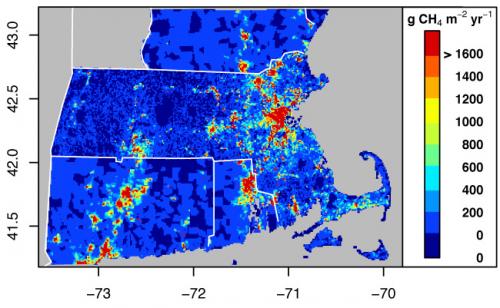
HARVARD-LED STUDY REVEALS AGING NATURAL GAS DISTRIBUTION SYSTEM SHORT-CHANGES CUSTOMERS, CONTRIBUTES TO GREENHOUSE GAS BUILDUP
Imagine if every time you filled your car with gas, a few gallons didn’t make it into the tank and instead spilled onto the ground. That’s essentially what happens every day with the aging system of underground pipes and tanks that delivers natural gas to Boston-area households and businesses, with adverse economic, public health, and environmental consequences. Now a group of atmospheric scientists at Harvard School of Engineering and Applied Sciences (SEAS) has produced hard numbers that quantify the extent of the problem.
The Harvard-led team estimates that each year about 15 billion cubic feet of natural gas, worth some $90 million, escapes the Boston region’s delivery system. They calculated that figure by placing sophisticated air monitoring equipment in four locations: two atop buildings in the heart of Boston, and two at upwind locations well outside of the city. Then they analyzed a year’s worth of continuous methane measurements, used a high-resolution regional atmospheric transport model to calculate the amount of emissions, and concluded that:
- Some 2.7 percent of the gas that is brought to the Boston region never makes it to customers; it escapes into the atmosphere. That is more than twice the loss rate that government regulators and utilities estimate;
- Depending on the season, natural gas leaking from the local distribution system accounts for 60 percent to 100 percent of the region’s emissions of methane, one of the most insidious heat-trapping greenhouse gases.
The findings have implications for other regions, especially cities that, like Boston, are older and rely on natural gas for a significant and increasing portion of their energy needs. While policymakers have focused on the production end of the natural gas supply chain—wells, off-shore drilling platforms, and processing plants—much less attention has been paid to the downstream gas delivery infrastructure. The new study, published today in the Proceedings of the National Academy of Sciences (PNAS), suggests that intra-city distribution and end use systems may contribute more to the nation’s overall methane emissions than previously understood.
Read more: Boston’s natural gas infrastructure releases high levels of heat-trapping methane
The Latest on: Methane emissions
[google_news title=”” keyword=”Methane emissions” num_posts=”10″ blurb_length=”0″ show_thumb=”left”]
via Google News
The Latest on: Methane emissions
- Reducing Methane Emissions: How Creating Less-Gassy Cows Could Combat Climate Changeon April 26, 2024 at 11:35 pm
A Curtin University study has revealed breeding less-flatulent cows and restoring agricultural land could significantly reduce rising methane emission levels, which play a considerable role in climate ...
- States Challenge Federal Methane Rule, Citing Cost and Interference with Energy Productionon April 26, 2024 at 6:42 pm
At the heart of the legal battle is a rule introduced by the Bureau of Land Management (BLM), designed to minimize methane waste and pollution on federal lands. The regulations set a new precedent by ...
- New Cornell research paving the way for reduced methane emissions from dairy farmson April 26, 2024 at 3:20 pm
Dairy farming remains a critical segment of the economy in Western New York and as the conversation surrounding climate change grows, the need to adapt and reduce methane emissions while still being ...
- Zero Waste Houston will turn your food scraps into compost, reducing greenhouse emissionson April 26, 2024 at 5:03 am
The company picks up customer food scraps weekly, for a low cost starting at $10 a month, and turns it into nutrient-rich soil for local farms and gardens.
- Red states sue Interior over methane ruleon April 26, 2024 at 3:53 am
The legal challenge aims to overturn new limits on greenhouse gas emissions from oil and gas drilling on public lands.
- Methane Eating Microbes - A Novel Solution For Greenhouse Gas Mitigationon April 25, 2024 at 7:00 am
Methane is a significant contributor to human-driven greenhouse gas emissions, but there is useful group of microbes that can help because they use methane for food.
- EPA issues toughest rule yet on power plant emissions, but it's likely to face court challengeson April 25, 2024 at 3:58 am
Coal-fired power plants would have to capture smokestack emissions or shut down under a new EPA rule the industry says would make the grid less reliable. It's likely to face court challenges.
- Colorado companies join coalition in methane-seeking space missionon April 24, 2024 at 11:30 am
Colorado has led the nation on regulating methane emissions and now companies in the state are major contributors to a new satellite expected to be an important tool in identifying and quantifying ...
- ‘Invisible’ contributor: Methane leaks from landfills are likely worse than previously thoughton April 23, 2024 at 4:16 pm
A new study looking at landfill emissions revealed the industrial waste dumps are likely punching above their weight when it comes to methane leaks. The report, which revealed a significant ...
- Cornell launches advanced effort to study methane emissions from cowson April 23, 2024 at 12:05 pm
Cornell University revealed new specialized chambers on Monday designed to measure methane and other gases emitted by cows, marking a significant advancement in agricultural sustainability research.
via Bing News










